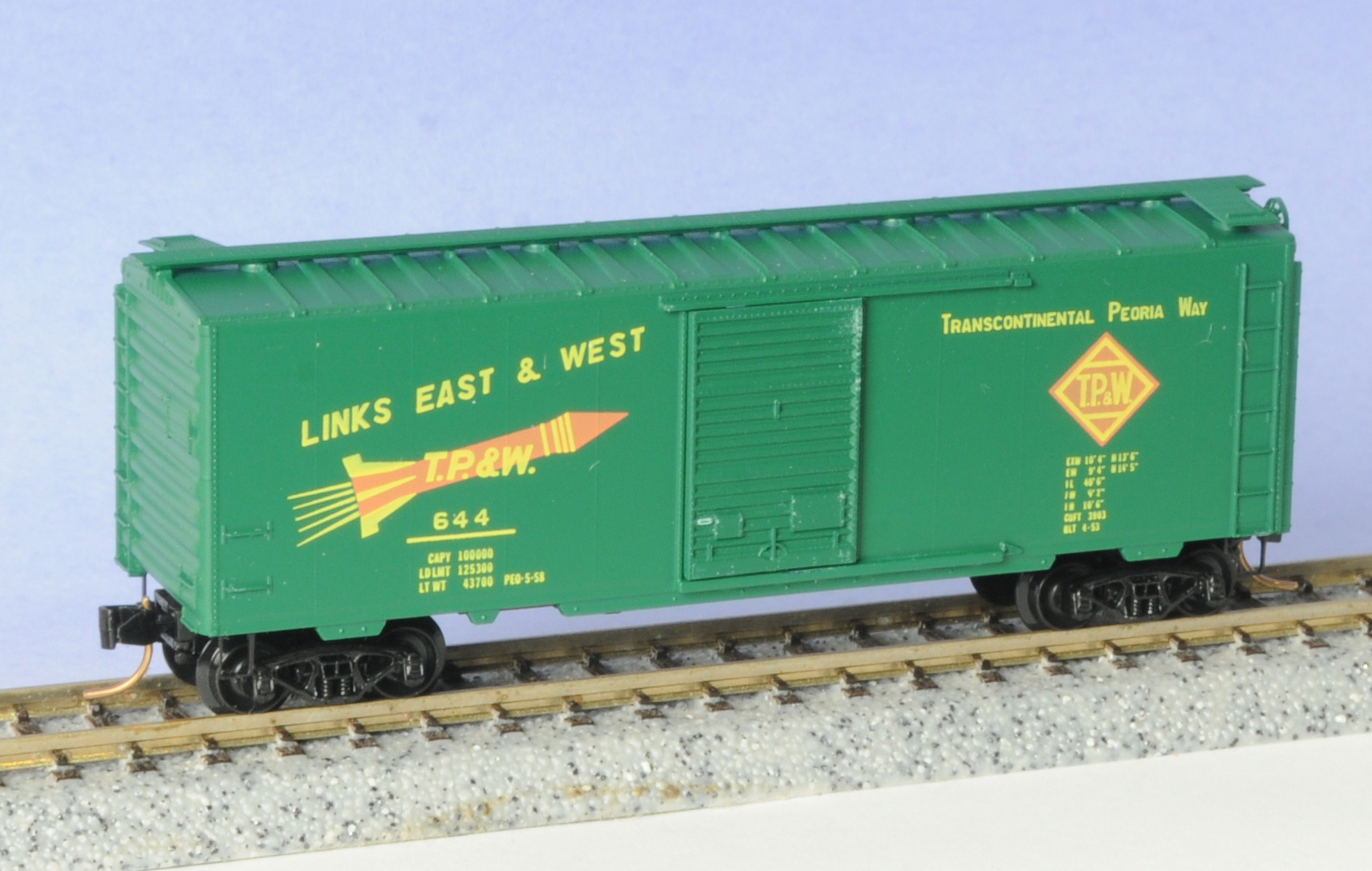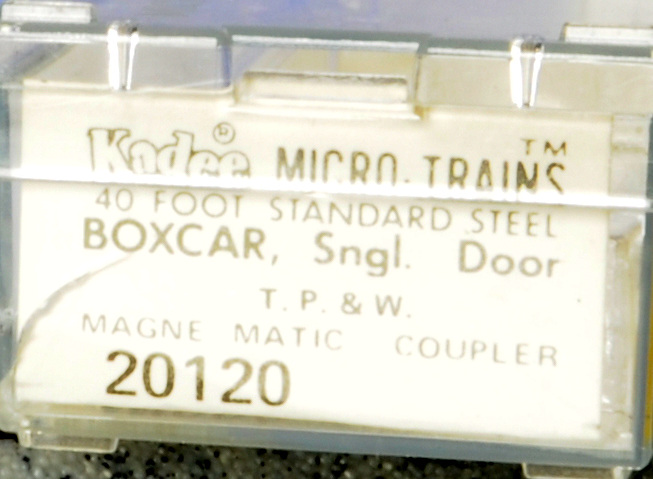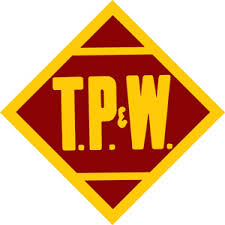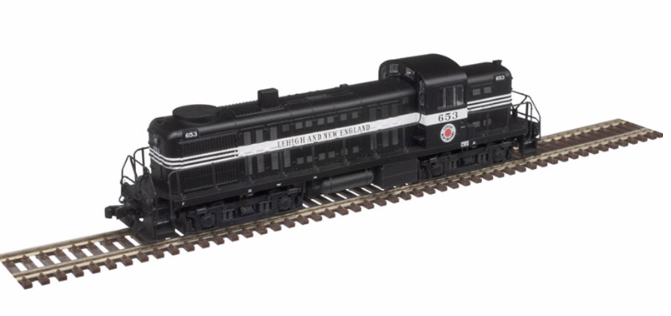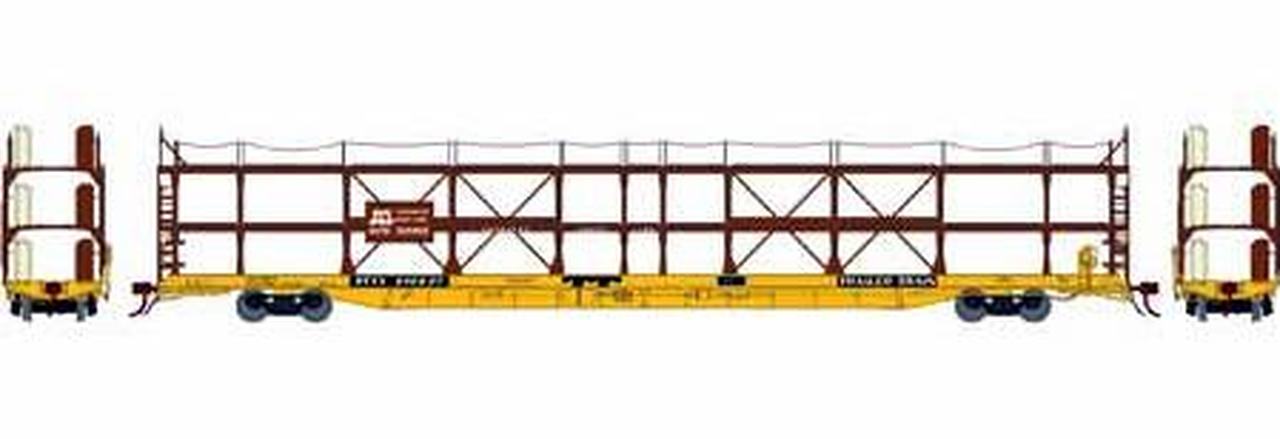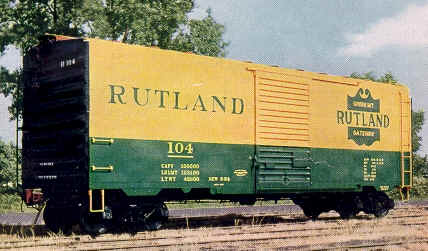Model Information: This is Micro-Trains first body style. It was introduced in 1972. Its is a model of a Pullman-Standard PS-1 boxcar from circa 1957. Micro-Trains does not market it as a PS-1 so as to allow themselves some latitude so they can use this car to model non-PS prototypes. Hundreds of different releases have used this body style in various paint schemes and road names. They are equipped with 6' sliding doors, either Youngstown (4/5/4 rib pattern) or Superior (7 panels). It is not a model of a "modern" steel boxcar as the length (40 foot) and the roofwalk are more typical of the transition era (1939 - 1957).
In 2019, Micro-Trains started releasing this model with new body-mounted couplers attached to a new underframe.
In 2019, Micro-Trains started releasing this model with new body-mounted couplers attached to a new underframe.
Prototype History: The 40' Boxcar is widely known as one of the most popular freight cars used by railroads as they transitioned from steam to diesel. In particular the Pullman Standard or PS-1 design was one of the most popular and was widely used by North American railroads. These boxcars were built beginning in 1947 and share the same basic design, with certain elements such as door size, door style or roof type varying among the different railroads and production years. When production of these cars ceased in 1963, over 100,000 had been produced.
So just what is a PS-1? Well the simple answer is it is any boxcar built by Pullman Standard from 1947 on. The design changed over the years – sometimes subtly, sometimes for customer request, and sometimes in a larger way. In general, most PS-1’s built from 1947 to 1961 share the same dimensions and basic construction techniques. These cars all had a length of 40′, a height of 10’5″ or 10’6″, welded sides and ends and roof of Pullman’s own design. The greatest variation was in the size and style of doors used. Pullman Standard also offered 50′ and later 60′ boxcars – also with the PS-1 designation.
So just what is a PS-1? Well the simple answer is it is any boxcar built by Pullman Standard from 1947 on. The design changed over the years – sometimes subtly, sometimes for customer request, and sometimes in a larger way. In general, most PS-1’s built from 1947 to 1961 share the same dimensions and basic construction techniques. These cars all had a length of 40′, a height of 10’5″ or 10’6″, welded sides and ends and roof of Pullman’s own design. The greatest variation was in the size and style of doors used. Pullman Standard also offered 50′ and later 60′ boxcars – also with the PS-1 designation.
Road Name History: TP&W first appeared under that name in 1887. For most of its history, the TP&W ran east and west from Peoria, Illinois, to Keokuk, Iowa on the west bank of the Mississippi River on one end and Effner just on the other side of the Illinois-Indiana state line. There were a couple of short branches on the west end of the line.
TP&W first attracted national attention in 1887 when a passenger excursion train wrecked in Chatsworth, Illinois. The double headed train originated in Peoria and was packed with excursionists headed for Niagara Falls (via connections.) The train was running at speed when it approached a low trestle that had been weakened by a prairie fire. The trestle was only about 15’ high. The lead locomotive made it across and the second engine plunged through it, bringing the train of wooden coaches to an instant halt. At least one of the coaches was telescoped by another. 85 were killed and hundreds injured.
In 1941, TP&W backed out of national labor negotiations over a pay increase that was being considered. TP&W instead pushed for hourly wages and loosening of work rule restrictions. The unions struck and with the outbreak of war, operations were taken over by the Federal Government. After the war, the government handed the operation back to the owner George McNear and the labor strike resumed. In 1947 McNear was assassinated by a striker and that was that. The railroad was sold and operation resumed.
In addition to the local traffic they generated across central Illinois, TP&W served as a bridge route between the Santa Fe at Lomax, Illinois near the west end and the Pennsylvania at Effner, Indiana on the east end. Santa Fe and Pennsy’s only direct connection was in Chicago with all of Chicago’s inherent congestion. Many traffic managers preferred to route through Peoria. For Santa Fe and Pennsylvania, that meant routing over the TP&W.
In the steam era, the kings of the TP&W were a group of six 4-8-4 Northerns purchased in 1937. These Alco’s were the smallest 4-8-4’s on the continent. The diesel era was dominated by Alco and EMD road switchers with a splash of F’s and Lima-Hamilton switchers (these were later replaced by SW1500’s.)
In 1960, the Minneapolis & St. Louis attempted to gain control of the TP&W as well as Monon. M&St.L was also a funnel for the Peoria Gateway and thought the TP&W a good addition. However, when Santa Fe and Pennsy got wind of M&St.L’s stock purchases, the Santa Fe put out their own buy order and quickly grabbed control away from M&St.L. Santa Fe then sold a 50% stake in the TP&W to the Pennsylvania.
In 1970, TP&W suffered a wreck in Crescent City, Illinois. A string of propane tank cars was involved. One of the cars caught fire. As it burned, it boiled the propane in the adjacent car. Eventually the pressure of the boiling fuel exceeded the strength of the fire weakened shell of the tank and it exploded. The cycle started again with the next car. The fire department had successfully evacuated Crescent City but was powerless to fight the fire as burning propane rained down on the town. Crescent City was all but destroyed and the accident led the FRA to set standards on track quality with power to embargo traffic from lines that fell below certain maintenance levels.
The creation of Conrail in 1976 changed traffic patterns for the TP&W. Bridge traffic to the Santa Fe began to dry up. TP&W bought the ex-PRR line from Effner to Logansport, Indiana and a new connection to N&W was established. This brought the TP&W mileage to just over 300 making it about the size of Ann Arbor.
In 1979 the corporate successor of Penn Central sold their half of the TP&W to Santa Fe. At the end of 1983, TP&W was merged into the Santa Fe. In 1986, 33 miles of former TP&W line toward the west end were sold to Keokuk Junction Rwy. But the story didn’t end there.
In 1989, the TP&W lines were spun off by Santa Fe to a group of investors and the TP&W was reborn. The 1995 BNSF merger brought trackage rights for TP&W over the former CB&Q from Peoria northwest to Galesburg. A year later, TP&W was purchased by Delaware Otsego Corporation who also owned the New York Susquehanna & Western and a few shortlines in the New York – Pennsylvania – New Jersey area. During DO ownership, a typical day saw 165 cars move on the line. In 1999, the RailAmerica shortline group made an offer for the TP&W that DO couldn’t refuse and that September, the sale was closed. In 2004, the lines west of Peoria were sold to Keokuk Junction with TP&W continuing with the routes east. In 2012, all of the RailAmerica roads, TP&W included, joined the Genesee & Wyoming shortline group.
TP&W first attracted national attention in 1887 when a passenger excursion train wrecked in Chatsworth, Illinois. The double headed train originated in Peoria and was packed with excursionists headed for Niagara Falls (via connections.) The train was running at speed when it approached a low trestle that had been weakened by a prairie fire. The trestle was only about 15’ high. The lead locomotive made it across and the second engine plunged through it, bringing the train of wooden coaches to an instant halt. At least one of the coaches was telescoped by another. 85 were killed and hundreds injured.
In 1941, TP&W backed out of national labor negotiations over a pay increase that was being considered. TP&W instead pushed for hourly wages and loosening of work rule restrictions. The unions struck and with the outbreak of war, operations were taken over by the Federal Government. After the war, the government handed the operation back to the owner George McNear and the labor strike resumed. In 1947 McNear was assassinated by a striker and that was that. The railroad was sold and operation resumed.
In addition to the local traffic they generated across central Illinois, TP&W served as a bridge route between the Santa Fe at Lomax, Illinois near the west end and the Pennsylvania at Effner, Indiana on the east end. Santa Fe and Pennsy’s only direct connection was in Chicago with all of Chicago’s inherent congestion. Many traffic managers preferred to route through Peoria. For Santa Fe and Pennsylvania, that meant routing over the TP&W.
In the steam era, the kings of the TP&W were a group of six 4-8-4 Northerns purchased in 1937. These Alco’s were the smallest 4-8-4’s on the continent. The diesel era was dominated by Alco and EMD road switchers with a splash of F’s and Lima-Hamilton switchers (these were later replaced by SW1500’s.)
In 1960, the Minneapolis & St. Louis attempted to gain control of the TP&W as well as Monon. M&St.L was also a funnel for the Peoria Gateway and thought the TP&W a good addition. However, when Santa Fe and Pennsy got wind of M&St.L’s stock purchases, the Santa Fe put out their own buy order and quickly grabbed control away from M&St.L. Santa Fe then sold a 50% stake in the TP&W to the Pennsylvania.
In 1970, TP&W suffered a wreck in Crescent City, Illinois. A string of propane tank cars was involved. One of the cars caught fire. As it burned, it boiled the propane in the adjacent car. Eventually the pressure of the boiling fuel exceeded the strength of the fire weakened shell of the tank and it exploded. The cycle started again with the next car. The fire department had successfully evacuated Crescent City but was powerless to fight the fire as burning propane rained down on the town. Crescent City was all but destroyed and the accident led the FRA to set standards on track quality with power to embargo traffic from lines that fell below certain maintenance levels.
The creation of Conrail in 1976 changed traffic patterns for the TP&W. Bridge traffic to the Santa Fe began to dry up. TP&W bought the ex-PRR line from Effner to Logansport, Indiana and a new connection to N&W was established. This brought the TP&W mileage to just over 300 making it about the size of Ann Arbor.
In 1979 the corporate successor of Penn Central sold their half of the TP&W to Santa Fe. At the end of 1983, TP&W was merged into the Santa Fe. In 1986, 33 miles of former TP&W line toward the west end were sold to Keokuk Junction Rwy. But the story didn’t end there.
In 1989, the TP&W lines were spun off by Santa Fe to a group of investors and the TP&W was reborn. The 1995 BNSF merger brought trackage rights for TP&W over the former CB&Q from Peoria northwest to Galesburg. A year later, TP&W was purchased by Delaware Otsego Corporation who also owned the New York Susquehanna & Western and a few shortlines in the New York – Pennsylvania – New Jersey area. During DO ownership, a typical day saw 165 cars move on the line. In 1999, the RailAmerica shortline group made an offer for the TP&W that DO couldn’t refuse and that September, the sale was closed. In 2004, the lines west of Peoria were sold to Keokuk Junction with TP&W continuing with the routes east. In 2012, all of the RailAmerica roads, TP&W included, joined the Genesee & Wyoming shortline group.
Brand/Importer Information: Micro-Trains is the brand name used by both Kadee Quality Products and Micro-Trains Line. For a history of the relationship between the brand and the two companies, please consult our Micro-Trains Collector's Guide.
Manufacturer Information:  Kadee Quality Products originally got involved in N-Scale by producing a scaled-down version of their successful HO Magne-Matic knuckle coupler system. This coupler was superior to the ubiquitous 'Rapido' style coupler due to two primary factors: superior realistic appearance and the ability to automatically uncouple when stopped over a magnet embedded in a section of track. The success of these couplers in N-Scale quickly translated to the production of trucks, wheels and in 1972 a release of ready-to-run box cars.
Kadee Quality Products originally got involved in N-Scale by producing a scaled-down version of their successful HO Magne-Matic knuckle coupler system. This coupler was superior to the ubiquitous 'Rapido' style coupler due to two primary factors: superior realistic appearance and the ability to automatically uncouple when stopped over a magnet embedded in a section of track. The success of these couplers in N-Scale quickly translated to the production of trucks, wheels and in 1972 a release of ready-to-run box cars.
In October 1990 Kadee separated in two companies, with the newly created Micro-Trains® Line Co. continuing the Z, Nn3, and N Scale product ranges, with Kadee retaining the HO range.

In October 1990 Kadee separated in two companies, with the newly created Micro-Trains® Line Co. continuing the Z, Nn3, and N Scale product ranges, with Kadee retaining the HO range.
Item created by: nscalemodeler160 on 2016-04-06 11:28:19. Last edited by gdm on 2021-02-13 18:08:40
If you see errors or missing data in this entry, please feel free to log in and edit it. Anyone with a Gmail account can log in instantly.
If you see errors or missing data in this entry, please feel free to log in and edit it. Anyone with a Gmail account can log in instantly.


